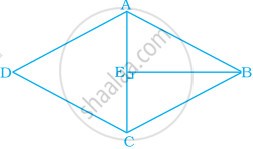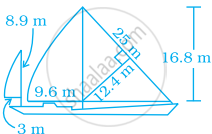Advertisements
Advertisements
प्रश्न
One of the diagonals of a rhombus is thrice as the other. If the sum of the length of the diagonals is 24 cm, then find the area of the rhombus.
उत्तर
Let one of the diagonals of rhombus be ‘d1’ cm and the other be d2 cm.
Give d1 = 3 × d2
Also d1 + d2 = 24 cm
⇒ 3d2 + d2 = 24
4d2 = 24
d2 = `24/4`
d2 = 6 cm
d1 = 3 × d2 = 3 × 6
d1 = 18 cm
∴ Area of the rhombus = `1/2` × d1 × d2 sq.units
= `1/2` × 18 × 6 cm2
= 54 cm2
Area of the rhombus = 54 cm2
APPEARS IN
संबंधित प्रश्न
If perimeter of a rhombus is 100 cm and length of one diagonal is 48 cm, what is the area of the quadrilateral?
The area of a rhombus is 100 sq.cm and length of one of its diagonals is 8 cm. Find the length of the other diagonal
The area of the rhombus with side 4 cm and height 3 cm is
The area of the rhombus when both diagonals measuring 8 cm is
The area of the rhombus is 576 sq.cm and the length of one of its diagonal is half of the length of the other diagonal then find the length of the diagonal
The figure ABCD is a quadrilateral in which AB = CD and BC = AD. Its area is ______.

What is the area of the rhombus ABCD below if AC = 6 cm and BE = 4 cm?

If the diagonals of a rhombus get doubled, then the area of the rhombus becomes ______ its original area.
Area of a rhombus = `1/2` product of ______.
Most of the sailboats have two sails, the jib and the mainsail. Assume that the sails are triangles. Find the total area of sail of the sailboats to the nearest tenth.

